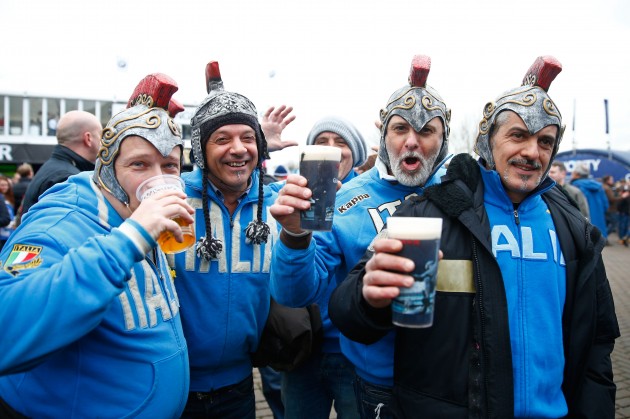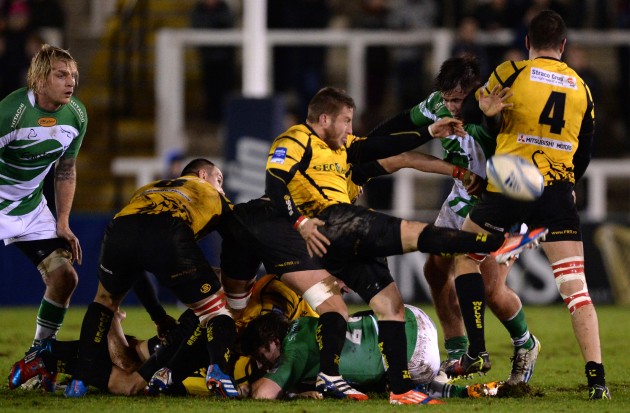With yesterday's draw still fresh in the mind, we took a piece from our May issue which seeks to address ways the EPCR could improve the Champions and Challenge Cup...
The first season of the new European format has seen big crowds, stunning tries and thrilling rugby but with Toulon basking in a third consecutive title, it’s worth considering how to improve the competitions. Here are RW’s five suggestions…
1. Have an Italian finale
The decision to play this year’s Champions Cup final at Twickenham was understandable. It was the first season of a new competition and, with so many unknowns ahead last summer, it was a safe choice. London is accessible for fans, guaranteeing a sizable crowd (with lots of incentive), while it is also convenient for the sponsors they need to attract to ensure the tournament’s long-term future.
We now know the Stade des Lumieres and Murrayfield have been plucked out host the 2016 and 2017 Finals but looking forward, isn’t it time Italy hosted a European final. Before anyone questions the logic in holding a final in a nation unlikely to have a side playing in it, you need only look at history to know this is not imperative to a successful venue.
The Millennium Stadium hosted a record five Heineken Cup finals and no Welsh team played in any of them (Cardiff played in the first final at the Arms Park). Did that mean the atmosphere was diluted for any of those games? Did it heck! Take Munster’s two European wins – the crowd was as deafening and as passionateas as any Wales International.
Murrayfield emphasises the point. The ground hosted two Heineken Cup finals, yet no Scottish team had ever reached a Euro final until Edinburgh faced Gloucester this year.
Before the tournament shake-up, this year’s final was due to be held at the San Siro in Milan and that plan should be revisited sooner rather than later. For a start it gives fans (and journalists!) a trip to relish – a springtime weekend in Italy would appeal to anyone.
On top of that it would grow the game. Top-class European rugby could draw more Italians to the sport, especially if played outside of Rome where most of the Azzurri games are held.
Capturing a new audience should be a priority for this tournament and doing so in Italy would also provide an indicator of what an Italian World Cup would look like. As Test flanker Simone Favaro told us last year: “Italy needs to bring people closer to rugby – they need a big event.”
2. EXPAND THE THIRD TIER
A key selling point of the new European competition was expanding it to include more clubs from more nations. Yet there has been little evidence of this.
The third-tier tournament this season involved Italy’s Rovigo and Calvisano, Georgia’s Tbilisi Caucasians and Bucharest Wolves from Romania. After play-offs in September, Rovigo and Wolves qualified for this season’s Challenge Cup.
The qualifying competition has been expanded for 2015-16. Clubs from Italy, Russia, Spain and Portugal were split into two three-team pools at the start of this year, with the winners playing off against Rovigo and Wolves across two legs over the coming weeks for a place in next season’s Challenge Cup.
Is this enough? We have received letters campaigning for a European league featuring teams from Georgia, Romania, Spain, Portugal, Russia, Germany and so on – all rugby markets ripe for growth. Yes, the logistics would be difficult. Yes, it would cost money. But surely getting more teams and countries involved is good for the game. Attracting an audience in new markets can also bring in more sponsors.
So here’s an idea: make the third-tier event a season-long competition. It can have pools and knockout stages that run alongside the Champions and Challenge Cups, with the winners moving up a tier the next year. The final could even be played as a curtain-raiser to the main Champions Cup event.
If rugby is to truly grow, let’s integrate emerging nations into big competitions – and quickly.
3. MAKE IT THE BEST OF THE BEST
This is a controversial one and may seem at odds with the idea of hosting the Champions Cup final in Italy, but here goes. Qualification for the Champions Cup should be a pure meritocracy: the top six from the Premiership and the Top 14, along with the top seven in the Pro12, regardless of where the sides are from. The 20th place would go to the Challenge Cup winner (see point four).
Yes, this plan would mean that, if we took this season, the Italian sides would not be playing in the Champions Cup next term – but is that really such a bad thing? How much would Treviso have gained from conceding more than 100 points in their back-to-back games with Northampton? Would the more realistic prospect of qualifying for the Challenge Cup quarter-finals not be of greater benefit? It would surely help morale to be competitive and would be more enjoyable for supporters to watch, while it also removes the unfairness of the pool containing the Italian side almost being guaranteed two quarter-final spots, as happened with Saints and Racing Metro this year.
Of course, in another year it might be the Scots who miss out. The probabilities are better for the Welsh and Irish, with four teams each, but surely the top performing teams should be in the elite competition.
The Champions Cup is for the best of the best, not a team that finishes 11th in the table but because they’re slightly better than the other team from Italy/Scotland/AN Other they get a place. In 2012-13 Treviso actually finished seventh in the Pro12 table so it’s not an impossibility for them to qualify either – it would just mean that when they do, it will be on merit not by default.
4. REWARD THE CHALLENGE CUP WINNER
In the old format, winning the second-tier event secured a team qualification for the elite competition the next season. Or if they had already qualified through league form, the best team from their country yet to qualify would get a place.
Now it’s more complicated. If the Challenge Cup is won by a Top 14 or Premiership club that has not already qualified for the Champions Cup via their league, they go into the play-off ahead of the seventh-placed team in their league for a chance to qualify for next season’s elite competition. If the Challenge Cup is won by a Pro12 team, they just get the trophy – there is no route into the Champions Cup except via league form.
So where’s the incentive? Yes, silverware is great – but in the pro era financial benefits take precedence. For proof of this, look at the French sides’ efforts in the Challenge Cup this term, with no French side reaching the quarter-finals. For them, it made more sense to focus on the Top 14. As Grenoble coach Bernard Jackman said: “The Challenge Cup is a bit pointless in terms of first-grade players. There’s no real benefit unless we win it. And even if we do, we wouldn’t be guaranteed a place in the next Champions Cup.”

Bittersweet: Gloucester won the Challenge Cup, but would an automatic entry into the Champions Cup be fairer?
Automatic Champions Cup qualification for the Challenge Cup winner would solve this problem. Teams could fight on two fronts to achieve the goal and would no doubt take the Challenge Cup more seriously.
It would also mean scrapping the qualification play-offs. Yes, they add a little drama but with concerns over player welfare, losing a few games from the calendar is no bad thing. If the Challenge winner has qualified for the Champions Cup already, the place would go to the next best finisher from their league.
5. SORT THE SEEDINGS
Working out the Champions Cup seedings is as tricky as doing the seating plan for the Oscars. But having three semi-finalists from the previous year’s competition in the same pool is not right. Clermont, Saracens and Munster were all in Pool One this season and such a draw is far from ideal. And this year we have the dreaded Pool 5, which houses four sides (Toulon, Bath, Wasps and Leinster), who have won the tournament NINE times between them.
Of course, none of the pools are supposed to be easy – that was the point of reducing the competition from 24 teams to 20 – but balance is also important.

We meet again: Bath and Wasps, both quarter-finalists last year have ended up with Leinster and holders Toulon
The 2015 World Cup pools shows how seedings can skew a tournament. With the draw made in late 2012 – a ludicrous three years before the event – Australia, England and Wales were drawn in the same pool because of Wales’ brief drop down the rankings. Those teams are now all ranked in the top six in the world and yet one of them won’t make it to the knockout phase of RWC 2015. Holding the draw at least a year later would have averted that.
So how do you solve the seedings issue in the Champions Cup? This season’s seedings were based purely on teams’ league positioning whereas in the Heineken Cup days weight was given to their previous form in Europe – for example, Munster may have had a poor league season but were known for performing in Europe.
How about a rankings system that combines both league position and performances in the last two European seasons? More complicated, yes, but some brainiacs out there can work it out – call in Duckworth and Lewis from cricket for a little help! It would avoid a repeat of this year’s Pool One.
*This article appeared in our May issue of Rugby World. Click here for the latest subscription offers and find out how to download the digital edition here.








